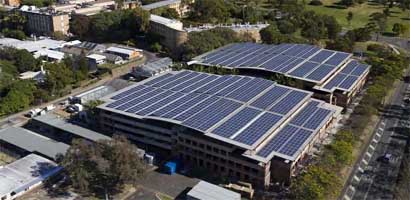
Renewable Energy Year in Review. A summary from the Clean Energy Council (CEC) 2011 Report
In the year to October 2011, just under 10 per cent of Australia’s electricity came from renewable energy.
Australia’s national Renewable Energy Target will deliver 20% of the country’s electricity from renewable sources by 2020.
The industry is expecting that the Federal Government’s carbon price package will signal the beginning of a new era of policy stability that will secure commitment to major clean energy projects.
Investment in clean energy has eclipsed that of traditional energy over the last three years and this shows no signs of slowing down. Investors have started to see clean energy as a safe and lucrative sector to invest their capital.
Australia’s electricity generators produced over 300 terawatt-hours of electricity in the last year to the end of September 2011. The contribution of renewable energy rose to 9.6 per cent of the total electricity produced during this period, up from 8.7 per cent the year before.
Household clean energy technologies
The growth of solar power was one of the stories of 2011 following a record year in 2010, when 380 MW of solar power was installed. As at the end of August 2011, 1031 MW of solar power was installed across the country, representing more than half a million household systems. This is more than nine times the amount of solar power installed as at the end of 2009 and more than 35 times the total installed just three years ago in 2008.
More than 230,000 of these systems were installed in the eight months from January to August 2011.
Large-scale renewable energy projects
There were modest gains for industrial-scale renewable energy over the last year, repeating the pattern from the year before. A dozen large-scale renewable energy power plants have become operational since October 2010, though most of the 400 MW in new generating capacity came from three wind farms and a hydro upgrade. Although this figure is higher than in 2010, it is still well down on the 993 MW of power that came online in 2009.
Electricity prices in Australia have risen about 30 per cent over the last four years.
There are several factors behind the recent price rises. By far the largest is the need to replace and upgrade the ageing poles and wires of the national electricity grid, some of which have been in service for more than 40 years. Recent estimates suggest that more than $130 billion will be necessary to upgrade the network over the next decade, growing to $220 billion over 20 years. Research indicates that these network costs will cause price rises of up to 66 per cent in NSW and Queensland by 2015. Similar increases are likely in other states and territories.
Other reasons for power price rises include the increasing cost to generate electricity with both coal and gas along with the increased use of energy-intensive appliances such as air-conditioners and flat-screen televisions, which increase peak demand for electricity and overall costs.
Australian Renewable Energy Snapshot
The renewable energy generated during the 12 months to the end of September 2011 produced enough electricity to power the equivalent of more than 4 million average Australian households.
A summary of Australia’s nine major clean energy technologies
- Bioenergy
8.5% of total clean energy generation
- Geothermal
0.002% of total clean energy generation
One geothermal plant is currently operating and another three projects are under development in Australia.
- Hydroelectricity
67% of total clean energy generation
Hydropower produces enough electricity for 2.8 million average Australian homes.
- Solar PV
2.3% of total clean energy generation
Australians from all walks of life are embracing solar PV, including those from so called mortgage belt and retirement suburbs across the country.
- Large scale solar
The nation’s largest solar photovoltaic plant is a 1.2 MW facility at the University of Queensland’s St Lucia campus.
- Solar hot water
The energy saved from solar water heating is equivalent to 7.2% of the clean energy generated in Australia.
- Marine energy
0.003% of total clean energy generation
- Wind energy
22% of total clean energy generation
- Energy efficiency
Water heating is the single largest source of greenhouse gas emissions from Australian homes, with heating and cooling together representing the greatest proportion of household energy use.
Whitegoods such as refrigerators and freezers are major contributors to household energy use, consuming 34 per cent of all energy used by household appliances.
73% of people wanted more information on how to save energy in their households.
Download the full Clean Energy Australia Report 2011 (This a zipped file due to the file size. Download then right click and select extract all)

